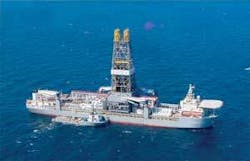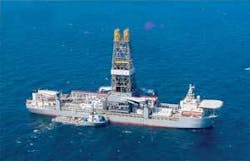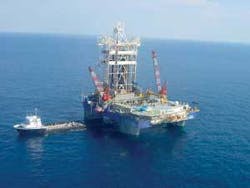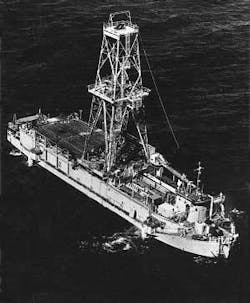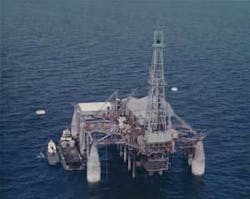Working ‘the float’: Bottom rigs sufficient for Gulf in early days, but West Coast needed ‘floaters’
Companies that today own ultra-deepwater drillships, semisubmersibles owe a debt of gratitude to those intrepid drillers who dreamed of finding oil, gas off California
By the early 1960s, development of ship-shaped rigs and “semis” had extended the offshore industry’s water depth drilling capability to nearly 1,000 ft. Meanwhile, as technology for automatic rig station-keeping became a practical alternative to conventional anchor-based mooring systems, working water depths for floaters reached out into even deeper water.
Today’s combined worldwide fleet of mobile offshore drilling units is plentiful (more than 1,170 rigs) and represents a tremendous total investment by a group of highly experienced, technology savvy drilling companies. What’s more, an immense new construction campaign in certain divisions of the fleet is taxing the financial wherewithal of some contractors, as well as a number of operators.
For many years, offshore drillers with U.S. headquarters dominated the mobile rig market. But when exploration and production began its gradual spread beyond U.S. waters, newly formed contractors arrived on the scene, most based in Western Europe. Today, offshore drilling company ownership is more international in scope than ever. Drillers from the Middle East, from Southeast Asia and Japan, and from several Central and South American countries operate offshore rigs around the world. What’s more, they have major new units under construction.
Meanwhile, as operator demand for leading-edge deepwater and ultra-deepwater drilling equipment has increased to full swing, contractors have ordered construction of the newest generations of such rigs, which can drill extremely deep wells in unprecedented water depths virtually anywhere on the planet. Many of them are nearing completion, while the majority are still under construction and will emerge from shipyards during the next 3-4 years.
A recent survey of deepwater rigs under construction reveals that a total of 17 sixth-generation, dynamically positioned (DP) drillships (Figure 1), each of which represents construction costs in the equivalent of hundreds of millions of U.S. dollars, are in various stages of construction mainly at shipyards in the Far East. If no new drillships were to be ordered, this batch would represent a whopping 30% of the entire world deepwater drillship fleet of 56 units. Most of these rigs will no doubt work in the deepwater areas of the “Golden Triangle,” i.e., the Gulf of Mexico, off West Africa and off Brazil.
Additionally, no fewer than 44 mostly sixth-generation, DP deepwater semisubmersible drilling units (Figure 2), each costing roughly the same as the drillships, are now in various stages of construction, again mainly in Far Eastern shipyards. This batch, if no new semis were to be added, would represent 21% of the existing world semisubmersible fleet of 210 units. Most of them are destined for long-term contacts somewhere in the Golden Triangle areas, too.
The majority of both types of these newest generation of deepwater rigs have drilling water depth capabilities of 10,000-12,000 ft, and are equipped with rig packages capable of drilling to 30,000 ft, with a few able to drill up to 40,000-ft wells.
Drilling in the deep, blue sea
In the industry’s earliest days, the chief motivation for floating rig development was, of course, deeper water. In the Gulf of Mexico, the industry’s bottom-supported rig technology was keeping up with the ever so gradual deepening of water as producing companies leased more seaward acreage.
But the Pacific Ocean off California - dating from the wells-on-piers era of the 1890s to when modern open-water drilling got fully underway in the Gulf in the 1950s - has always cast an allure of oil and gas probability. Most geologists declared that it contained vast reserves. The issue intrigued major and independent oil companies alike.
On land, California’s significant oil and gas activity, including development of fields located literally on the beach and beneath bays, indicated that robust hydrocarbon potential existed out beyond the surf line. A handful of producers headquartered in the Los Angeles area, all quite familiar with the regional geology, searched for ways to tap those potential offshore reserves.
According toPioneering Offshore: The Early Years, the depth of waters along the Pacific Coast deepened abruptly, with the 600-ft outer continental shelf (OCS) depth contour of about 600 ft located only a few miles out to sea.
“As one engineer put it: ‘You could tee up a golf ball on a bluff and easily drive it out to a platform in 300 feet of water’.”
The book explains that oil companies had recognized early on that the drilling equipment used in the Gulf - bottom-supported rigs - was not adequate for most West Coast drilling. Only a floating rig of some kind would do for deepwater exploratory and field delineation work. Fixed steel platforms remained a possibility for developing discoveries if recoverable reserves were found in large enough quantities. If not, then some type of seafloor production system probably would be needed to get production to shore.
CUSS-ing allowed off California
Technology development for floating drilling moved in several directions, the book notes. In the late 1940s, Shell Oil Co., in conjunction with the U.S. Navy and the University of California, began to investigate drilling not only along the Pacific Coast, but in other deepwater areas of the world, as well.
In 1948 Shell also joined three other companies - Conoco, Union Oil Co. of California (Unocal) and Superior - to form the acronymic CUSS group, which had deepwater drilling off California specifically in mind. With that viewpoint, the group experimented with various forms of motion-restricted, ship-shape drilling vessels.
The CUSS group began operations in 1953 with a converted, 300-ton naval petrol craft to which they added a drawworks and an over-the-side drilling floor and derrick, which caused barely manageable listing problems. This vessel, theSubmarex, and a few others were used to take cores of the ocean bottom with mobile, over-the-side derricks and rotary equipment. Examining the geological makeup of the cores helped the CUSS companies determine areas that overlaid possible oil and gas reservoirs.
“In any case, despite her limited capabilities, the Submarex remained in service through the late 1960s. But scarcely a year after she was put to work, the vessel’s relatively small size, coupled with the problems associated with the side-mounted rig, convinced CUSS officials to go beyond shallow coring to full-bore drilling.”
The group purchased a surplus navy YF barge, on which they positioned a full-size rotary drilling rig directly over a hole built through the vessel’s hull (Somebody quickly nicknamed it the “moon pool,” which it’s still called today). This diamond-shaped aperture allowed the drilling and hoisting equipment to be installed over the barge’s midline, rather than over the side, for much improved stability while drilling. Aptly, the unit was christened theCUSS I, and according to the book, it contained some distinctive equipment (Figure 3).
“Two other unique features went into the CUSS 1 design. Special vertical guides welded inside the derrick served as rails along which the frame of the rig’s six-ton traveling block moved. The frame contained sheaves for the wire rope that moved up and down from the drawworks during drilling. The vertical guides kept the traveling block from swaying dangerously in response to vessel motion. In fact, from that point on, builders fitted rails for all traveling blocks on the derricks of floating MODUs. Also, engineers installed a mechanical pipe-handling system that stacked stands of tubulars (casing, drill pipe, and weighted drill collars) horizontally on deck and could raise them quickly to the vertical position in the derrick for lowering into the hole. This system achieved two things. First, it eliminated the need to rack tubulars in the derrick, a common practice on land rigs and bottom-supported MODUs, but obviously unsafe aboard a floating rig. Second, it all but eliminated the sometimes-dangerous job of derrick man. Maintenance and other non-drilling duties, however, at times still required men to work high in the derrick.”
Tightly moored by a series of anchors linked with chains and buoys, theCUSS I allowed the use of the drill string itself to convey the blowout prevention equipment and drilling base to the sea-bottom, eliminating the need for a riser. A simple slip-joint was added to the drill string to compensate for vertical motion. This non-self propelled barge was capable of drilling in water depths to 350 feet. According to the book, it easily withstood the roughest storms the Pacific Ocean could offer.
That CUSS is Global
In 1963, when the CUSS group disbanded, theCUSS I drilling barge served as the first vessel in the fleet of a new offshore contract driller, Global Marine Drilling Co., which went on to build a series of much larger, self-propelled “drillships.” Once water depths presented anchor-handling and sheer weight problems, contractors experimented with electronically operated dynamic positioning systems that, using powerful thrusters, could keep drilling barges and drillships over the subsea wellhead in great water depths and on storm-tossed seas.
In fact, with only a rudimentary station-keeping system on board, theCUSS I rig was used to take cores in more than 11,000 ft of water during the short-lived Operation MOHOLE project. Global Marine also supplied the first drilling/coring vessel for the Deep Sea Drilling Project, a government-sponsored geological/oceanographic initiative that continues even today. Drillships caught on rather quickly in the offshore marketplace, particularly since they could drill in deep, California-type water depths and face oncoming seas with better stability than any other rig type.
“In 1961, Global Marine elected to order not one, but several new self-propelled drillships, each with a package and mast rated for centerline drilling of 20,000-foot wells in water depths to 600 ft. The company christened each with the CUSS forename followed by its respective number, e.g. CUSS II, III, IV, and so on. But due to problems with the Arabic translation of the word “cuss,” Global changed the rigs’ forenames in 1964 to Glomar, followed by the number.
After some delay in raising the necessary financing, the brunt of which Shell eventually guaranteed, Global Marine ordered the first of this new drillship class, the 5,500-dwt CUSS (Glomar) II, from a Gulf Coast shipyard. The ship cost around $4.5 million - at the time a high-ticket outlay, indeed. Nevertheless, at 268 ft in length and with a 58-ft beam - almost twice as large as the CUSS I - the world’s first drillship built as new construction set sail in 1962.”
Meanwhile, the company’s series of Glomar drillships and those of other companies were used along with other floating rig types - semisubmersibles - to spread deepwater drilling to the world’s seven seas and beyond. As deepwater drilling technology advanced, the water depth capabilities of both floating rig types were increased accordingly.
The submersible we call ‘semi’
In the mid-1950s, Shell engineers began working on ways to partially ballast a floating hull to remove most of the motion such buoyant forms experience at sea. The main goal was to mitigate the effects of that motion on the large-diameter pipe string that was necessary for drilling wells in deep water from a floating rig. On rigs with full sea bottom contact this pipe, called the riser, ascends from the seabed through the water column, ending at the blowout preventer (BOP) installed at the surface just below the rig’s drill floor. But for floating rigs, the book notes, the riser would have to absorb all of the sea’s motions without kinking or breaking, and the BOP would be flanged to a seafloor wellhead.
This and related research proceeded throughout the 1950s, and Shell engineers and scientists also spent considerable time investigating seafloor wellhead systems, wellhead re-entry, and the use of both fixed and buoyant, remotely operated vehicles (ROVs) to help accomplish those and other subsea tasks. This pioneering work resulted in a lot of the highly dependable subsea production equipment that is used offshore today.
After designing a semi-floating hull fabricated with the use of large-diameter steel tubulars, Shell worked with several equipment manufacturers to fashion a freestanding riser that with the aid of tensioners would allow the hull and its drilling system to be moored over subsea wellhead equipment, free from direct contact with the bottom. With this tensioned riser and a gimbaled rotary, the book points out, the floating rig’s hull could stay connected to the well, rising, falling and yawing with the ocean’s heave, pitch and roll, regardless of water depth.
After long-term testing of several prototypes of the semi-floating rig, Shell joined with a new drilling contractor, Bluewater Drilling Co., to develop an existing submersible rig into a ballasted, column-supported structure called a “semisubmersible” drilling unit, which, when partially submerged, offered superior stability for deepwater drilling. This first “semi,” into which the submersible was modified in 1962, was theBluewater No. 1 (Figure 4). An improved unit, built from the keel up, the Bluewater No. 2, followed it shortly into the deepwater fleet.
“Several (other offshore contractors) quickly fashioned their own semisubmersible rig versions, mainly by modifying existing submersibles. In 1963, however, Odeco stepped up to build the first brand-new ‘semi,’ the Ocean Driller, a V-shaped unit with the drilling package placed over the middle of the V, closer to the center of buoyancy.”
Sedco arrives with 135s
A sizeable land drilling contractor, Southeastern Drilling Co. (Sedco), of Dallas, embraced the semi as its single rig type for deepwater drilling. It ordered the naval architecture firm Friede & Goldman to design a rig they could use both as a floating and bottom-supported drilling unit. The result was theSedco 135-class rig, which was commissioned at a New Orleans shipyard for $6.5 million. At the time, this was one of the costliest rigs in existence. But according to the book, the rig was special.
“The Sedco 135, with a well drilling depth rating of 25,000 ft, could work while resting on bottom to a water depth of 135 ft, hence the name. For floating drilling, its water depth capability reached an astounding 600 ft. Its mooring system, particularly the anchor chain, was much larger than those used for other rigs. This, of course, contributed significantly to overall cost.”
The Sedco semi was widely used around the world as a dependable deepwater rig that took a licking and kept on ticking. The Shell companies leased it exclusively for a number of years. Meanwhile, in the period 1965-1972, as worldwide deepwater exploration expanded, Sedco secured contracts - many with Shell - to build no less than 12 variations of the 135-class semi. The price tag went up steadily with each new unit, which came equipped with ever more advanced drilling and mooring technology and the ability to operate in increasingly deeper and more severe ocean environments.
Since then, the book observes, the designs of both the drillship and the semisubmersible have been enhanced and combined to work with seafloor production and pipeline gathering systems in most of the world’s deepwater exploration areas. Additionally, lighter but stronger anchor mooring systems were developed to allow both rig types to work routinely in water depths exceeding 5,000 ft.
In fact, a study conducted recently by theOffshore Magazine editorial staff confirms that semisubmersibles rated for working water depths ranging from 600 ft to 1,000 ft and fitted with both conventional mooring and dynamic positioning systems, are the second most-prevalent rig in the world rig fleet, behind jackups. Many of the semis are water-depth limited, so a number of them have been used in some areas as semi-permanent floating production stations, servicing scores of subsea wellheads and other seafloor production equipment.
Dynamically positioned drillships, while fewer in number than semis, are used to drill in remote, often ultra-deepwater areas - in the Gulf and off West Africa and Brazil - where conventional mooring is not practicable.
